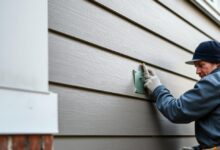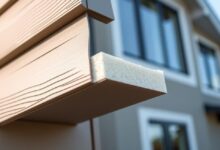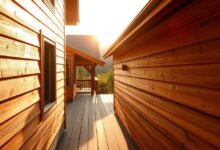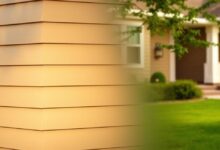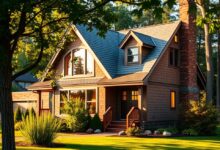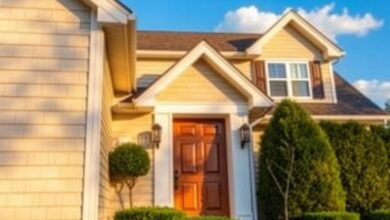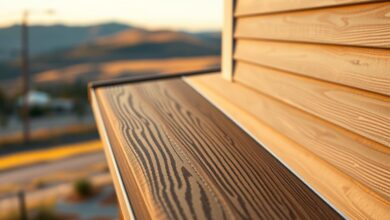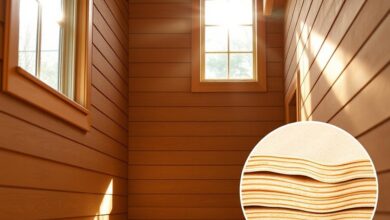Fiber Cement Insulated Siding: Durable, Energy-Efficient Protection
Homeowners are searching for durable and energy-efficient ways to protect their homes. Fiber cement insulated siding is becoming more popular. It offers long-lasting protection and helps save on energy costs.
This siding combines durability and energy efficiency. It’s a great choice for home upgrades. It keeps your home’s temperature steady, cutting down on heating and cooling needs.
Key Takeaways
- Durable protection against various weather conditions
- Enhances energy efficiency by reducing heat transfer
- Long-lasting, reducing the need for frequent replacements
- Can increase the value of your property
- Aesthetically versatile, available in various styles and colors
What Is Fiber Cement Insulated Siding?
Fiber cement insulated siding is a top choice for durable and energy-saving exterior finishes. It combines the strength of fiber cement with insulation benefits. This makes it a complete exterior cladding system for homeowners.
This siding is known for its superior durability and energy efficiency. It’s perfect for those wanting to improve their home’s look and save on energy costs.
Composition and Manufacturing Process
Fiber cement insulated siding is made from cement, sand, and cellulose fibers mixed with water. This creates a strong and durable material. Adding insulation to the board boosts its thermal performance, making it better than regular fiber cement siding.
The making process molds the mixture into boards, which are then cured and finished. This results in a product that’s durable and withstands many environmental factors.
How It Compares to Traditional Siding Materials
Compared to vinyl or wood siding, fiber cement insulated siding has big advantages. It’s more durable and resistant to damage from weather, pests, and fire. Its insulation also makes it more energy-efficient, which can lower heating and cooling costs.
Though it might cost more upfront, the long-term fiber cement siding benefits are worth it. It needs less maintenance and can increase your property’s value, making it a smart choice in the long run.
The Benefits of Fiber Cement Insulated Siding
Fiber cement insulated siding has many benefits. It’s energy-efficient and looks great. Homeowners love it for these reasons.
Superior Durability and Weather Resistance
This siding is known for being very durable. It can handle tough weather without warping, cracking, or rotting. This means your home’s exterior lasts longer.
Energy Efficiency and Thermal Performance
Fiber cement insulated siding is also energy-efficient. Its insulation keeps your home warm in winter and cool in summer. This can save you money on energy bills.
Here’s a comparison of energy efficiency features:
| Siding Type | Insulation Value | Energy Efficiency |
|---|---|---|
| Fiber Cement Insulated Siding | High | Excellent |
| Traditional Vinyl Siding | Low | Poor |
| Wood Siding | Moderate | Fair |
Fire Resistance and Safety Features
This siding is also fire-resistant. It’s made from non-combustible materials. This adds safety to your home, even in wildfire-prone areas.
Noise Reduction Properties
It also reduces external noise. The insulation layer blocks sounds. This makes your home quieter.
Aesthetic Options and Design Versatility
Fiber cement insulated siding comes in many styles and finishes. You can choose from modern to traditional looks. There’s something for everyone.

In conclusion, fiber cement insulated siding is a great choice for homeowners. It’s durable, energy-efficient, and versatile. It improves your home’s performance and looks.
Installation Process and Best Practices
To get the most out of fiber cement insulated siding, knowing how to install it right is key. A good installation means the siding lasts long, saves energy, and looks great.
Professional vs. DIY Installation Considerations
Homeowners face a choice: go pro or DIY with fiber cement insulated siding. Professional installation brings experience and a warranty, which can save money. Yet, DIY installation might be cheaper if you know what you’re doing. It’s important to think about what’s best for you.
Preparation and Planning Requirements
Getting ready for insulated siding installation is essential. You need to check the walls for damage and make sure they’re clean and level. Planning well means picking the right stuff, tools, and maybe getting pro advice to avoid mistakes.
Proper Techniques for Maximum Performance
How you install fiber cement insulated siding matters a lot. You must measure and cut it right, align it well, and fasten it securely. Sticking to the manufacturer’s guide and best practices ensures it works its best.
Common Installation Challenges and Solutions
Even with good planning, problems can pop up during installation. Issues like uneven surfaces, tricky spots around windows and doors, and sealing can be tough. Knowing these problems and having fixes ready, like the right flashing and sealants, helps a lot.
Maintenance Requirements and Long-Term Care
Keeping your fiber cement insulated siding in top shape is vital. Regular care helps it last longer and look great. It also keeps your home’s value and look up.
Cleaning and Regular Maintenance Schedule
It’s important to clean your siding regularly. Cleaning once a year is usually enough. But, this can change based on where you live and the weather.
Use a soft-bristle brush or a low-pressure washer with mild detergent. Don’t use high-pressure washes, as they can harm the siding.
Repainting and Refinishing Guidelines
The paint on your siding can fade or chip over time. Repainting can make your home look new again. You should repaint every 10 to 15 years, depending on the paint quality and your area’s climate.
Make sure to use exterior paint made for fiber cement siding. This ensures the best results.
Addressing Damage and Repairs
If you see damage like cracks or dents, fix it fast. For small issues, a patching compound can work. But, for bigger problems, you might need to replace the siding board.
Getting advice from a professional can help you decide the best fix.
| Maintenance Task | Frequency | Notes |
|---|---|---|
| Cleaning | Annually | Use mild detergent and low-pressure washer |
| Repainting | Every 10-15 years | Use high-quality exterior paint |
| Inspecting for Damage | Bi-Annually | Check for cracks, dents, and other forms of damage |
Conclusion: Is Fiber Cement Insulated Siding Right for Your Home?
Fiber cement insulated siding is a strong choice for homeowners. It’s durable, energy-efficient, and protects your home well. It’s great for those who want to keep their homes safe.
This siding also cuts down on noise, keeps your home warm or cool, and looks good. It’s a smart pick for many homeowners. But, it’s important to think about what you need and what you want.
Knowing how it’s made, installed, and maintained helps you decide. Fiber cement insulated siding is a top choice for durability and looks. It can also make your home more valuable over time.

